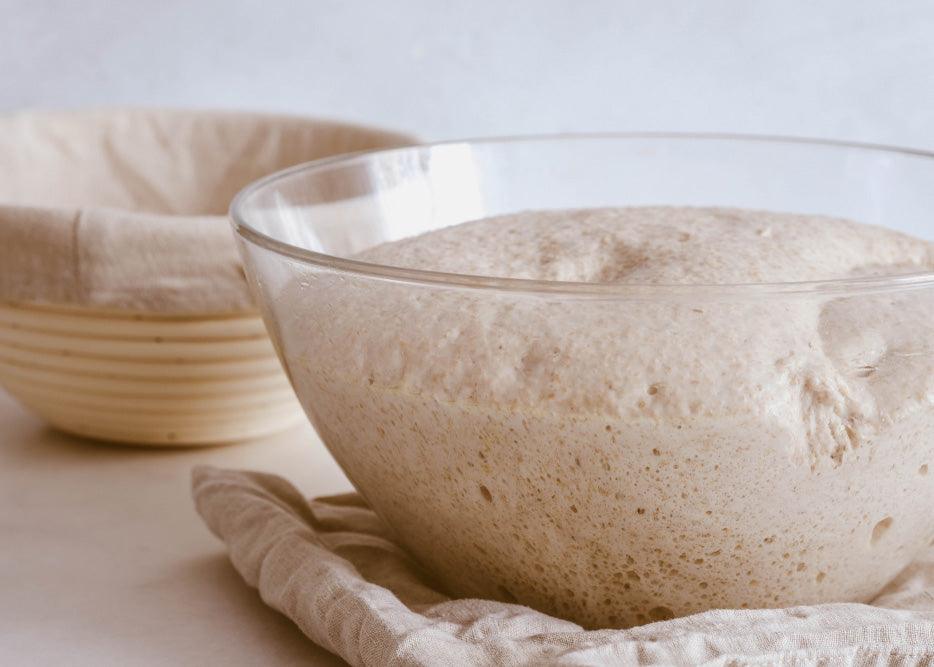We’ve all heard of fermentation, and in recent years, the trend has been to move towards incorporating more fermented foods into our diets. But what is fermentation exactly?
A chemical breakdown of a substance into a simpler substance? A chemical process that produces gas and turns sugar into alcohol? A process that aids in digestion? What does this even mean, and why does it matter?
Let’s break it down:
Fermentation is an indirect process that happens regardless of yeast quantity and temperature. It is primarily a result of bacteria and yeast proliferation. Bacteria and yeast are naturally living and occurring all around us: in the air, in the water, in the flour. There are more than 1,500 species of yeast, 250 of which can convert sugar into CO2 and alcohol, and 24 species of these 250 make our food taste good. In dough, wild yeast are the combination of these wild species that create fermentation. Sourdough starters/mothers/levains are all cultivated from these wild yeasts. Commercial yeasts (aka baker’s yeasts) on the other hand, come from the fungal species, Saccharomyces cerevisiae, which means “sugar-eating fungus.” This is one of the 24 species of yeast that makes our food taste good, and it has been used since the 19th century. Commercial strains of S. cerevisiae are selected for their flavor, aroma, and fermentative abilities. These commercial strains are the dry yeasts (ADY and Instant) and blocks of fresh yeast you will find in a supermarket. Naturally occurring wild yeasts are not necessarily strong enough to produce enough gas to double the size of your dough. However, they do contain lactic acid bacteria (LAB) and different chemical reactions.
Ok, but why do I need bacteria to make dough?
When you bake bread and pizza, you want them to rise in the oven. You want to develop a crumb structure (or gluten network) that is substantial and full of flavor. To achieve this, there are two important factors to think about when making dough: volume achievement and fermentation.
- Volume Achievement: rising process/leavening process
- Fermentation: bacteria and yeast proliferation
Depending on the quantity of yeast you use in your recipe, you can have the same volume achievement (rising/leavening) in the fermentation process in 2 hours (more yeast) as you can in 24 hours (less yeast). Soluble sugar ratio, strength of flour, and temperature/humidity are all controls that can be managed by bakers/pizzaioli that affect volume achievement.
There are two more important factors to keep in mind when making dough:
- Gas Retention: Capacity of gluten-network to retain the gas through fermentation/over time
- Gas Production: Capacity of the dough to develop gas gradually over time
When making dough, there needs to be a balance between gas production and gas retention. You need gradual volume achievement in a certain time, depending on temperature, humidity, quantity of yeast, and strength of flour.
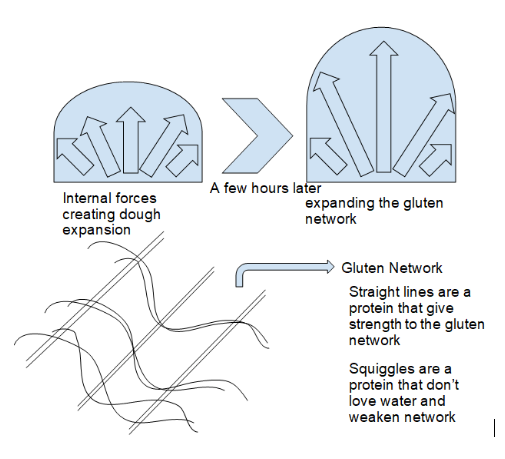
If you have more gas production than retention, time is decreased, and dough becomes weaker. Instead of doubling or tripling in volume, you get lateral expansion.
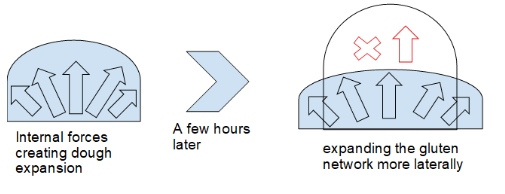
Ok, so fermentation leads to gas production/dough rising, but how does it impact digestion?
A hot term used over the last few years in relation to baking has been digestibility. In dough making, a long leavening process helps digestion. When dough begins to rise, enzymes in the flour (like amylase) start breaking down the complex sugars in the starch of the flour. Starch is a type of complex carbohydrate made of sugar molecules such as maltose and glucose linked together in chains. The yeast in the dough don't initially recognize these complex carbohydrates as food. So, with time, the flour's enzymes help by cutting these chains, making the sugar molecules more accessible to the yeast. Once the chains are broken, the yeast can then use the glucose and maltose molecules as a food source. As the yeast consume these molecules, they produce carbon dioxide gas, which causes the dough to rise.
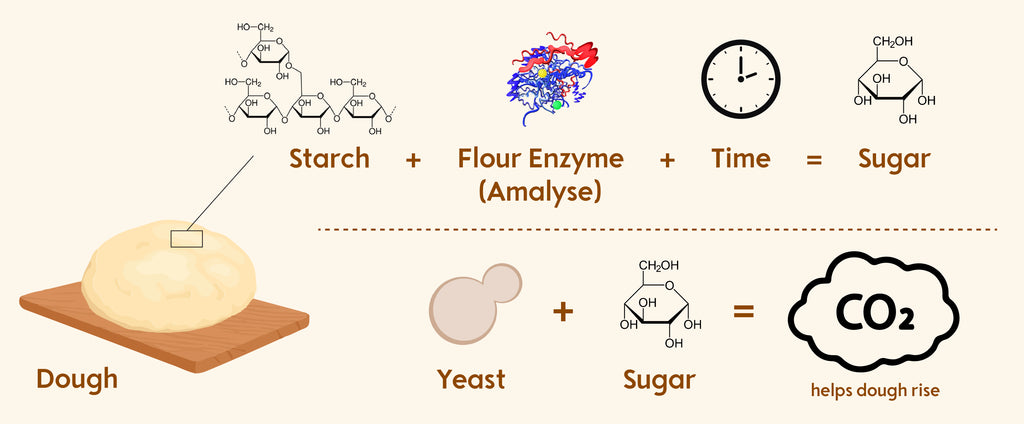
If we were to use a lot of yeast and ferment our dough for 2 hours, we would see a lot of volume as the surplus of yeast would easily eat the sugars and produce gas, but if we ate the final product, a large part of the starch still wouldn't be cut by the enzymes. If we give the enzymes more time to work (longer than 2 hours) with a lower quantity of yeast, we can still achieve the same amount of gas production, and when we eat the finished product, the starch will be more soluble and easier to digest.
In other words, if we put a lot of yeast into the dough, in a short amount of time, the yeast will eat the sugar-producing gas. In 2 hours, our dough is doubled or tripled. If we put a lower quantity of yeast, we have fewer yeast eating a lot of available sugar, and they need more time to produce gas. When the product is baked, we have a lot of soluble sugar that was worked on by the enzymes but not eaten by the yeast.
The same enzymes that exist in the flour exist in our saliva and stomachs, but since the complex carbs have already been broken down by the enzymes in the flour, our bodies don’t have to work as hard throughout digestion. As a result, we will digest the final product more quickly (for example, over 45 minutes instead of multiple hours).
Ok, so the quantity of yeast and the amount of time the dough has to ferment impact the digestibility of the dough. Does that mean there is a best type of pizza to eat for digestion?
The general rule of thumb is that with 24 hours of room-temperature fermentation, all styles are digestible. This is when you have all advantages and less risk of inconsistency. After 24 hours, the enzymes lose efficiency and make less of a difference in digestion. Prolonging fermentation for more than 24 hours has other benefits for the final product like taste, dough acidity, structure/gluten development, crumb expansion, color, etc.
50% of digestion comes from chewing. After 24 hours of leavening, there is a chance the product can become gummy, as there is no guarantee that a product will stay crispy. If a product is gummy, you won’t chew it enough, which means not as many enzymes will work to break down the remaining chains (the chewing movement helps the saliva break down the complex chains).
Are there benefits to room-temperature fermentation vs cold fermentation and vice-versa?
Longer fermentation (more than 24 hours) often requires cooler temperatures (a refrigerator) for added stability. Since ambient temperature frequently changes, it is very difficult to get consistent results over multiple days. However, using a refrigerator also has its risks, as it can speed up bacteria proliferation and stop the leavening, leading to water rejection after 24-48 hours. For example, after 24-48 hours of cold fermentation, have you ever seen water in your dough tray? The flour was rejecting the water because we stopped the leavening as the bacteria accelerated. There are a few ways to avoid this:
- Use a quality flour that is slowly milled and that does not have an excessive amount of damaged starch molecules. A high amount of damaged starch molecules will lead to water expulsion over longer, colder fermentations.
- Make sure your dough trays are fully dried before placing your dough balls in them, and store your trays in a cool, dry place when they are not in use. You can also stack your dough trays in opposite directions for 10 minutes in the cooler to allow the cold air to reduce the dough and tray temperatures.
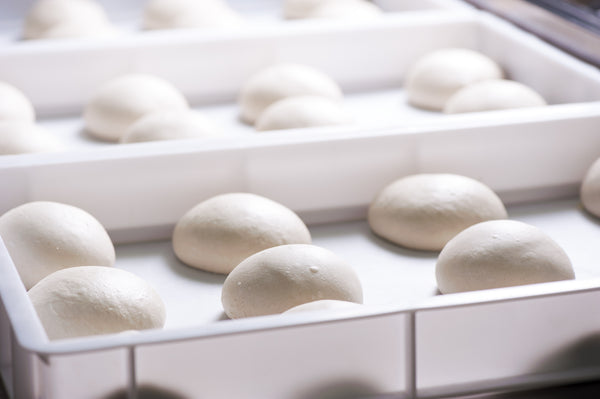
To Conclude:
In the world of dough-making, unlocking the alchemy of fermentation is akin to discovering the hidden keys to culinary enchantment. In unraveling the complexities of fermentation, we have navigated through the intricacies of yeast and bacteria proliferation, explored the significance of gas production and retention in dough making, and delved into the fascinating connection between fermentation and digestion. Armed with this newfound knowledge, both novice bakers and seasoned enthusiasts can embark on a journey where dough becomes a canvas for flavorful magic. This comprehensive guide demystifies fermentation and unveils the extraordinary potential within every rise, ensuring that the alchemy of dough-making is not merely a mystery, but an art form mastered, inviting all to savor the delights of their own culinary wizardry.

